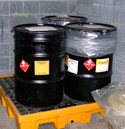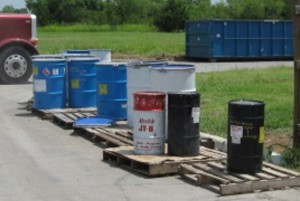49 CFR 173.12 contains many exceptions to full regulation for shipments of hazardous waste in a lab pack. In an earlier blog post I discussed the exception in 173.12(d)that removes the need to include the technical name of a hazardous material when shipping lab packs of hazardous waste with a generic shipping name such as: Waste Flammable Liquid, n.o.s. This article will focus on the relief from the requirements to segregate HazMat -including hazardous waste – in transportation, found in 173.12(e).
If the requirements of this section are met – more on that below – then lab packs of hazardous waste are not subject to the segregation requirements of…
- 49 CFR 174.81(d) for shipments by rail,
- 49 CFR 176.83(b) for shipments by vessel, or;
- 49 CFR 177.848(d) for shipments by highway,
The purpose of the segregation restrictions is to prevent the transportation, or storage in transportation, of hazardous materials that may be incompatible and thus pose an unreasonable risk to life, property, or the environment. However, PHMSA has determined that if packaged properly, the small volumes of hazardous waste in a lab pack can be transported safely without these restrictions.
Note that this exception to the segregation requirements does not apply to shipments by air. In that case, the requirements of the International Air Transport Association (IATA) must be complied with in addition to and separate from the regulations of the PHMSA/US DOT.
To be subject to the exception, the hazardous waste must be packaged as a lab pack. The PHMSA doesn’t define a lab pack, instead it refers you to the Appendix C Glossary of the RCRA Compliance Manual 2011 which defines a lab pack as “Drums filled with many small containers packed in non-biodegradable absorbent materials.” This type of packaging is most commonly used when a hazardous waste generator – not necessarily a “lab” – has many small containers of hazardous waste for disposal.
To use the exception, the lab pack must meet the requirements of 49 CFR 173.12(b) which first specifically identifies the hazardous wastes that may not take advantage of this exception or any other found in this section, they are:
- A material poisonous-by-inhalation
- A Division 6.1, Packing Group I material
- Chloric Acid
- Oleum (fuming sulfuric acid)
173.12(b) goes on to identify the Class and Division of lab packed hazardous waste that are authorized to use this exception as long as they are packaged in combination packagings as required by this section (see below) and are shipped for disposal by highway, rail, or cargo vessel; they are:
- Class 3 Flammable or Combustible Liquid
- Division 4.1 Flammable Solid
- Division 4.2 Spontaneously Combustible
- Division 4.3 Dangerous When Wet
- Division 5.1 Oxidizer
- Division 5.2 Organic Peroxide
- Division 6.1 Poison
- Class 8 Corrosive
- Class 9 Miscellaneous
What are the combination packaging requirements of this section that must be used if the hazardous waste lab packs are to utilize the exception? Well, briefly…
The inner packaging must either be glass of ≤4 L (1 gal) rated capacity or metal or plastic of ≤20 L (5.3 gal) rated capacity. Inner packagings of liquids must be surrounded by a chemically compatible absorbent material sufficient to absorb the liquid contents.
The outer packaging may contain only one Class of waste material, may not contain incompatibles (ie. acid and base, some organic and inorganic, etc.), and it must be a type of packaging listed in 49 CFR 173.12(b)(2)(ii). Note that the US EPA land disposal restrictions at 40 CFR 268.42(c) limit the packaging/container you may use if the entire lab pack is going straight to landfill or incineration. By and large a open-top steel drum of at least packing group III condition will be OK. Also The gross weight of the combined packaging (inner & outer packaging, absorbents and contents) may not exceed 205 KG (452 lb).
So, before you prepare a lab pack of hazardous waste for off-site shipment, ask yourself, “Is it…
- not a prohibited material?
- an authorized Class or Division?
- to be shipped by highway, rail, or cargo vessel?
- packaged in compliance with combination packaging requirements of 49 CFR 173.12(b)(2)(ii)?
If you answered ‘yes’ to all of the above, then lab pack shipments of the hazardous waste are not subject to the transportation segregation restrictions if they also are blocked and braced so that they are separated from incompatible materials by at least 4 feet horizontally and maintained at least 4 inches off the floor of the vehicle.
I suggest you read 173.12(e) as necessary for a full description of additional requirements for shipments of the following incompatible materials.
- The vehicle may not contain Class 1 explosives, Class 7 radioactive, or uncontainerized hazardous waste.
- Waste cyanides and waste acids must be packaged as specified in 173.12(e)(2).
- Waste Division 4.2 Spontaneously Combustible and Class 8 Corrosive Liquids must be packaged as specified in 173.12(e)(3).
- Waste Division 6.1, PG I, Hazard Zone A Poison Inhalation Hazards and Class 3, Class 8 liquids, or Division 4.1, 4.2, 4.3, 5.1, and 5.2 materials must be packaged as specified in 173.12(3)(4).
In the scope of a blog post like this, and with so many variable possible, I can only hope to outline the regulations and point you in the right direction to find the answer for yourself. If you ship lab packs of hazardous waste, you should make you and your
HazMat Employees very familiar with 49 CFR 173.12.



